Did you know that you can grow tomato plants in hanging baskets? This innovative vertical gardening technique allows you to enjoy cascading tomato plants right in your own home, even if you have limited space. With the right care and attention, you can create a vibrant tomato paradise in the air.
Key Takeaways:
- Select cherry or compact varieties bred for hanging baskets.
- Choose hanging planters designed for upside-down gardening.
- Transplant tomatoes carefully into the hanging containers.
- Ensure proper watering, soil management, and pruning for optimal growth.
- Place hanging planters in an optimal location with sufficient sunlight.
Selecting the Right Varieties for Hanging Tomato Plants
When it comes to hanging tomato plants, choosing the right varieties is key to success. Not all tomato varieties are suitable for hanging baskets or vertical gardening. To ensure optimal growth and abundant harvests, look for tomato plant varieties specifically bred for hanging. These varieties are typically cherry or compact, with a trailing habit that works well in limited spaces.
Here are some popular hanging tomato plant varieties that are known for their excellent performance:
| Variety | Description |
|---|---|
| Tumbling Tom | A compact cherry tomato variety that produces an abundance of small, flavorful tomatoes. It has a cascading habit, making it perfect for hanging baskets. |
| Gartenperle | Another cherry tomato variety that thrives in hanging baskets. It is known for its high yield of juicy, sweet tomatoes. Gartenperle’s compact growth and cascading vines make it a great choice. |
| Tomande | This variety is ideal for hanging baskets due to its determinate growth habit and vigorous fruit production. It produces clusters of tasty, red tomatoes and is perfect for vertical gardening. |
These hanging tomato plant varieties offer the perfect combination of flavor, productivity, and adaptability to the unique conditions of hanging baskets. By selecting these varieties, you’ll set yourself up for a bountiful harvest of delicious tomatoes.
Now that you know which varieties to look for, let’s move on to selecting the best hanging tomato planters. This will ensure that your plants have the right support and growing conditions.
Choosing the Best Hanging Tomato Planters
To grow thriving hanging tomato plants, it is crucial to select the best hanging planters that provide the ideal environment for their growth. When choosing hanging tomato planters, consider the following factors:
- Made specifically for upside-down gardening.
- Sturdy construction to support the weight of soil and plants.
- Lightweight materials to reduce overall weight.
- Proper drainage to prevent waterlogging.
Look for hanging baskets or containers designed specifically for upside-down gardening. These planters are often equipped with features that ensure optimal airflow, root development, and plant support. By selecting planters that are sturdy and lightweight, you can create a secure and manageable growing environment for your hanging tomato plants.
Hanging Tomato Planter Comparison:
| Planter Brand | Material | Size | Price |
|---|---|---|---|
| Gardman Hanging Planter | Plastic | 12 inches | $15.99 |
| Bosmere Tomato Plant Bag | Fabric | 14 inches | $12.99 |
| Lechuza Self-Watering Planter | Plastic | 16 inches | $29.99 |
| Smart Pot Big Bag Bed | Fabric | 20 inches | $19.99 |
Here is a comparison of popular hanging tomato planters:
- Gardman Hanging Planter: Made from durable plastic, this hanging planter measures 12 inches and is available at an affordable price of $15.99.
- Bosmere Tomato Plant Bag: Constructed of high-quality fabric, this 14-inch planter offers excellent drainage and is priced at $12.99.
- Lechuza Self-Watering Planter: With a 16-inch size, this plastic planter comes with a self-watering system and is priced at $29.99.
- Smart Pot Big Bag Bed: This 20-inch fabric planter provides ample space for tomato plants and is available for $19.99.
Consider the specific needs of your hanging tomato plants and choose a planter that meets those requirements. The right hanging planter will contribute significantly to the health, growth, and abundance of your tomato plants.
Transplanting and Care Tips for Hanging Tomato Plants
Proper transplanting and care are crucial for the success of hanging tomato plants. When transplanting, it’s important to handle the plants with care to minimize stress and ensure their well-being. Here are some tips to help you care for your hanging tomato plants:
Transplanting Tips:
- Wait until the tomato plants are at least one foot tall before transplanting them into the hanging containers.
- Choose lightweight potting soil to reduce stress on the hanging supports.
- Make sure the hanging containers have proper drainage to prevent waterlogging.
- Gently loosen the plant’s root ball and place it in the hanging container, ensuring it is at the same level as it was in its previous container.
- Water the transplanted tomatoes immediately after planting to settle the soil and provide essential hydration.
Transplanting the tomato plants with care will minimize transplant shock and promote healthy growth in their new hanging environment.
Care Tips:
To ensure the well-being of your hanging tomato plants, it’s important to provide regular care and attention. Support weak stems, prune for optimal growth, and maintain proper watering and soil management. Here are some care tips to consider:
- Support Weak Stems: As your tomato plants grow, some stems may become weak and require support. Use stakes or trellises to provide stability and prevent the stems from bending or breaking.
- Prune for Optimal Growth: Regularly prune your hanging tomato plants by removing suckers and lower leaves. This promotes vertical growth and increases air circulation around the plant, reducing the risk of diseases.
- Watering and Soil Management: Hanging tomato plants require regular watering to prevent the soil from drying out too quickly. Check the moisture levels regularly and water when the soil feels dry to the touch. Use lightweight potting soil with excellent drainage to facilitate proper water distribution.
By following these transplanting and care tips, you can ensure the health and vitality of your hanging tomato plants, leading to a bountiful harvest of delicious tomatoes.
| Transplanting and Care Tips for Hanging Tomato Plants |
|---|
Tips for Successful Hanging Tomato Plants
To ensure the success of your hanging tomato plants, there are some key tips to keep in mind.
-
Select the optimal location for your hanging planters: When choosing a location for your hanging tomato plants, consider factors such as weight support and sunlight exposure. Look for sturdy structures or hooks that can safely support the weight of the hanging baskets. Additionally, ensure that the chosen location receives adequate sunlight for healthy plant growth.
-
Protect your plants from wind: Wind can damage the delicate branches and leaves of hanging tomato plants. To shield your plants from strong gusts, consider implementing a windbreak or choosing a sheltered spot, such as a corner of your patio or backyard. This will help prevent wind damage and ensure your plants stay healthy.
-
Make seasonal adjustments: Take advantage of microclimates and the changing seasons to maximize sunlight exposure for your hanging tomato plants. Throughout the year, observe how the sun moves across your chosen location and adjust the placement of your hanging planters accordingly. By positioning them where they will receive the most sunlight during different times of the year, you can optimize growth and fruit production.
-
Use adjustable hanging mechanisms: Hanging tomato plants need to maintain the optimal distance from the ground to ensure proper growth and prevent damage. Use adjustable hanging mechanisms that allow you to easily raise or lower the height of the planters as needed. This flexibility will enable you to adapt to changes in plant size and growth throughout the season.
-
Regularly observe sunlight exposure: Consistent sunlight exposure is crucial for the success of hanging tomato plants. Although you have carefully selected a location with sunlight in mind, periodically check and confirm that the plants are receiving the expected amount of sunlight. Adjust the position of the planters if needed to achieve optimal exposure and ensure healthy growth.
By following these tips, you can create an optimal environment for your hanging tomato plants, promoting healthy growth, and ultimately, a bountiful harvest.
Reference:
“Tips for Successful Hanging Tomato Plants.” Adapted from source.
Growing Tomatoes in Hanging Baskets
Hanging baskets offer a fantastic way to grow tomatoes in a vertical garden. They not only save space but also create a stunning display of cascading tomato plants. In this section, I will guide you on how to grow tomatoes in hanging baskets effectively.
To begin, line the basket with a liner to prevent soil drainage. This ensures that the soil stays in place and doesn’t fall out through the holes. Once the basket is lined, fill it with a well-draining potting mix. The potting mix should be light, loose, and nutrient-rich, providing the optimal conditions for tomato growth.
Next, plant the tomatoes around the edge of the basket, facing outwards. This allows the tomato plants to cascade beautifully as they grow, creating a visually appealing arrangement. Be sure to choose compact or trailing tomato varieties that are well-suited for hanging baskets.
Watering is essential for the success of your hanging tomato plants. Thoroughly water the basket until the excess water drains out. Hanging baskets tend to dry out faster than traditional planters, so monitor the soil moisture regularly and adjust your watering routine accordingly. Remember, tomato plants thrive with consistent moisture but don’t overwater, as it can lead to root rot.
Hanging baskets are particularly suitable for small gardens, patios, or balconies. They add a touch of elegance and maximize the vertical space, allowing you to grow an abundance of tomatoes even in limited areas. Enjoy the beauty and convenience of growing tomatoes in hanging baskets!
Tips for Growing Tomatoes in Hanging Baskets
- Choose compact or trailing tomato varieties that thrive in hanging baskets.
- Ensure the hanging baskets have proper drainage to prevent waterlogging.
- Water the plants regularly to maintain consistent soil moisture levels.
- Select a location that provides adequate sunlight for optimal tomato growth.
- Fertilize the plants with a balanced tomato fertilizer to enhance their productivity.
Growing tomatoes in hanging baskets is not only a practical gardening technique but also a beautiful way to add greenery to your home. With the right care and attention, you can enjoy a bountiful harvest of delicious, homegrown tomatoes.
Caring for Hanging Tomato Plants
Proper care and maintenance are essential for healthy hanging tomato plants. To ensure the success of your vertical garden, it’s important to pay attention to watering and soil management. Here are some key tips:
Watering Routine
Due to increased air circulation, hanging tomato plants tend to dry out more quickly than those grown in the ground. As a result, it’s crucial to establish a regular watering routine to prevent the soil from becoming too dry.
Check the moisture level in the growing hole by inserting your finger about an inch deep. If the soil feels dry, it’s time to water. Be cautious not to overwater, as this can lead to waterlogged roots and damage the plants.
Remember to adjust your watering routine according to the weather conditions and the specific needs of your hanging tomato plants.
Soil Management
The choice of potting soil plays a significant role in the success of your hanging tomato plants. Opt for lightweight potting soil that provides excellent drainage. The soil should allow water to pass through easily, preventing waterlogging and root rot.
Consider adding a layer of organic mulch, such as straw or wood chips, around the base of your hanging tomato plants. This will help retain moisture in the soil, regulate temperature, and prevent weed growth.
Note: Image shows proper watering and soil management for hanging tomato plants.
Fertilization and Companion Planting
Implementing a regular fertilization schedule is essential for the healthy growth and productivity of your hanging tomato plants. Use a balanced liquid fertilizer or slow-release granules specifically formulated for tomatoes.
Furthermore, practicing companion planting can enhance the success of your hanging tomato plants. Consider planting herbs like basil, marigolds, or parsley nearby, as they can attract beneficial insects and deter pests.
| Key Points | Benefits |
|---|---|
| Regular watering routine | Prevents soil dryness and promotes healthy plant growth |
| Choice of lightweight potting soil | Ensures optimal drainage and prevents waterlogging |
| Use of organic mulch | Retains moisture, regulates soil temperature, and suppresses weeds |
| Regular fertilization and companion planting | Boosts plant nutrition and attracts beneficial insects |
Implementing these caring techniques will contribute to the overall health and productivity of your hanging tomato plants, resulting in a bountiful harvest of delicious homegrown tomatoes.
Pruning for Optimal Growth of Hanging Tomato Plants
Pruning plays a crucial role in promoting the optimal growth of your hanging tomato plants. By removing side shoots or suckers that emerge from the leaf axils when the plants reach around 12 inches in height, you can direct the plant’s energy towards vertical growth and enhance fruit production. It’s essential to regularly trim away any dead or yellowing leaves during pruning to maintain overall plant health and vigor.
When pruning your hanging tomato plants, remember to:
- Identify side shoots: Look for new growth emerging from the leaf axils and remove them by gently pinching them off. This helps redirect energy towards primary stem growth.
- Remove suckers: Suckers are shoots that grow in the joint between the main stem and a side shoot. Removing them helps prevent competition for nutrients and promotes better fruit development.
- Trim dead or yellowing leaves: Regularly inspect your plants for any leaves that have turned brown or yellow. Prune them off to maintain plant health and prevent the spread of diseases.
By pruning your hanging tomato plants regularly, you’ll ensure optimal growth, increased fruit production, and a healthier overall plant. Just remember to be gentle with your pruning techniques to avoid damaging the main stem or the remaining foliage.
Conclusion
Growing lush hanging tomato plants is not only a creative way to maximize your gardening space but also a rewarding experience. By carefully selecting the right varieties, using suitable planters, providing proper care, following essential tips and techniques, and practicing prudent pruning, you can turn your vertical garden into a thriving tomato paradise.
Remember to prioritize regular watering and soil management to ensure optimal growth and bountiful harvests. By taking advantage of companion planting, you can further enhance the success of your hanging tomato plants. With dedication and attention to detail, you can enjoy the delight of homegrown tomatoes right from your own hanging baskets.
So, whether you have a small balcony, limited garden space, or simply want to add an eye-catching feature to your landscape, growing lush hanging tomato plants is an excellent choice. Embrace this space-saving technique and get ready to savor the flavors of freshly picked tomatoes. Happy gardening!

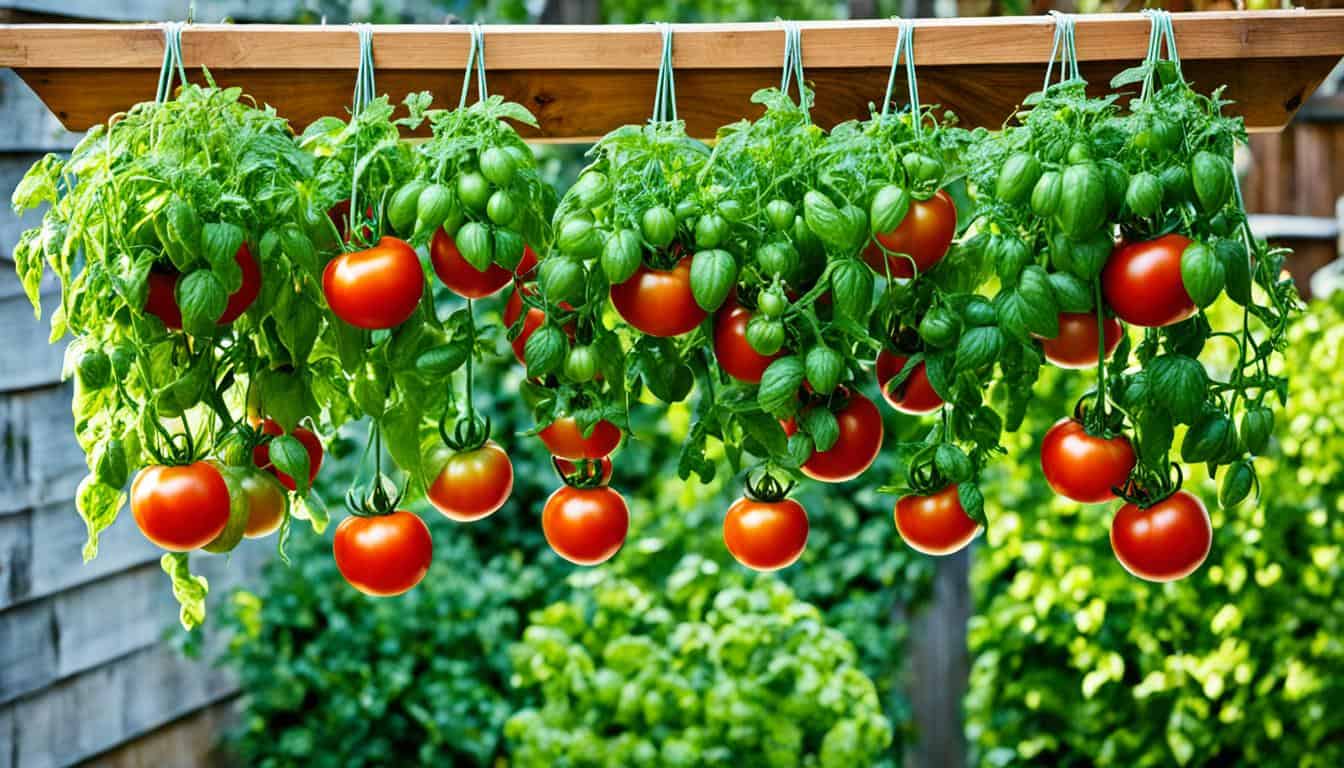
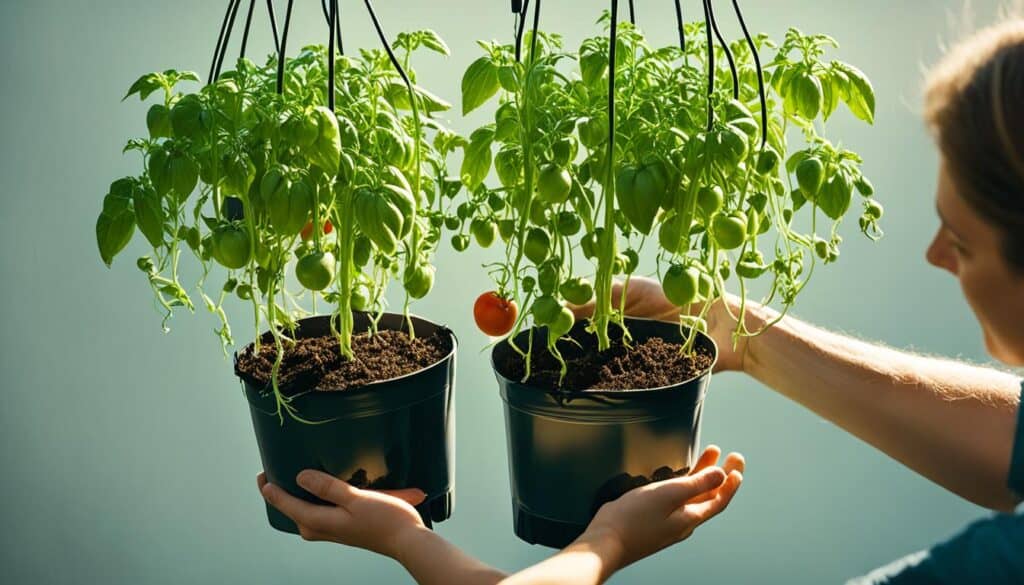
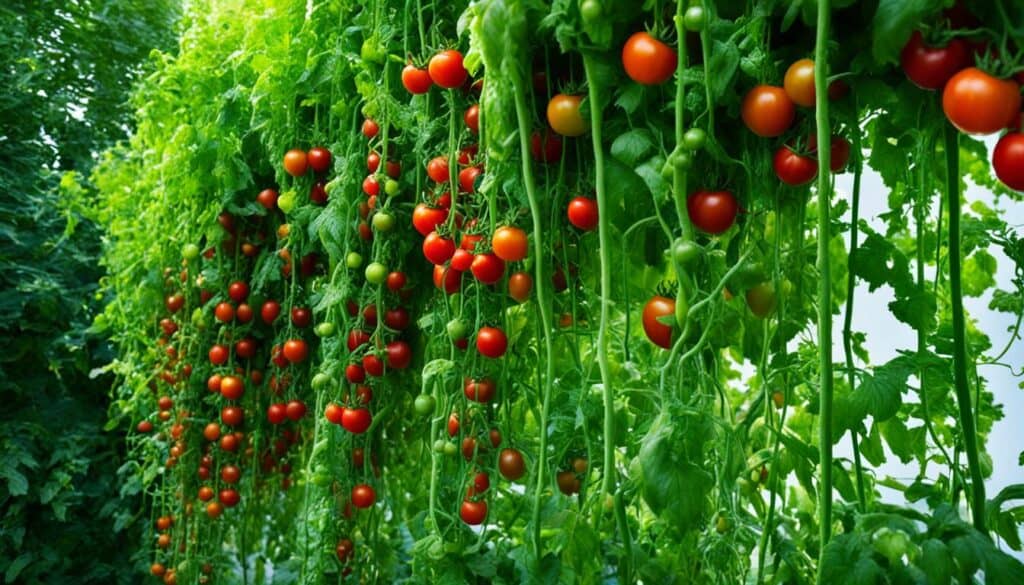
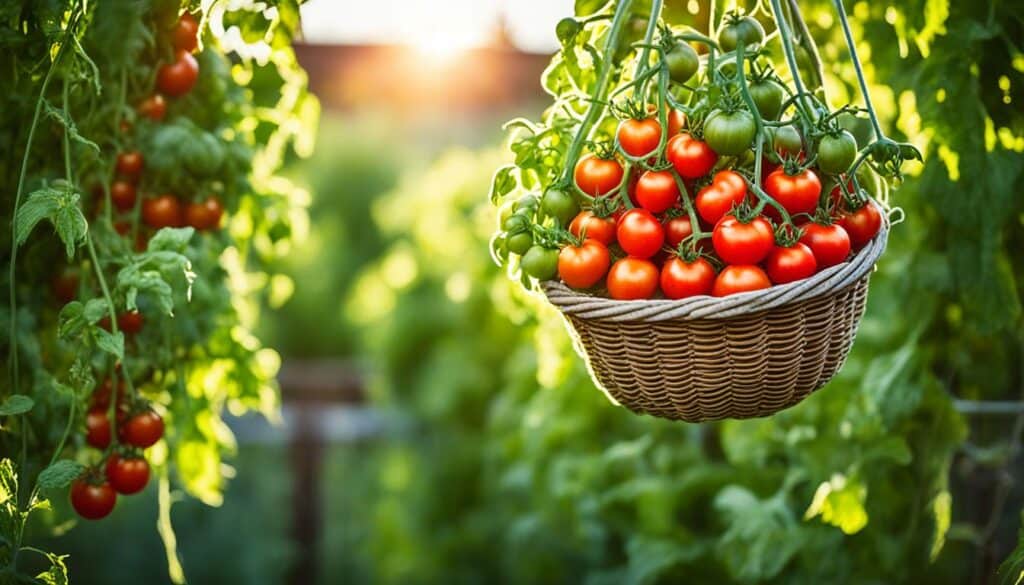
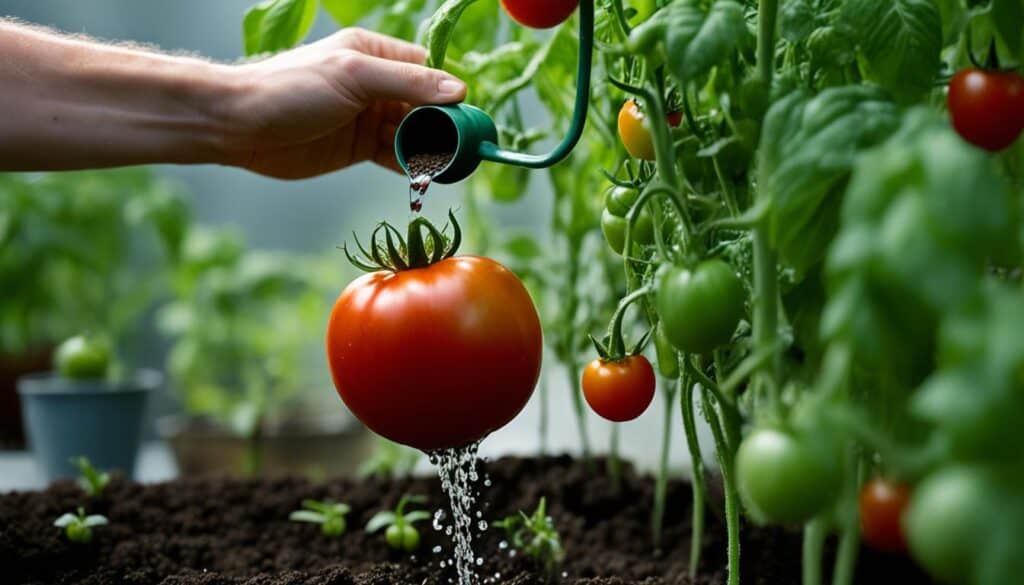
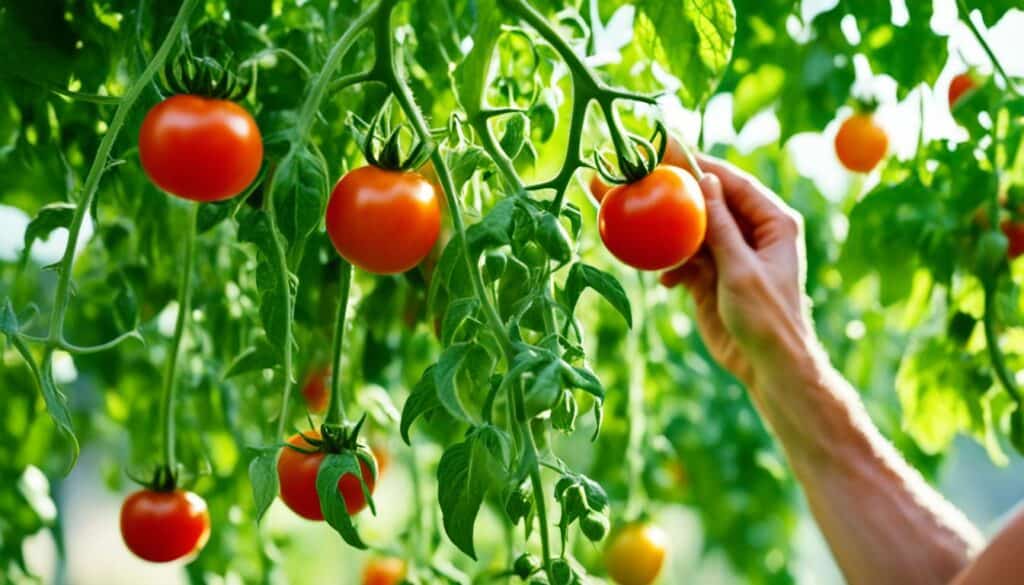



Leave a Reply